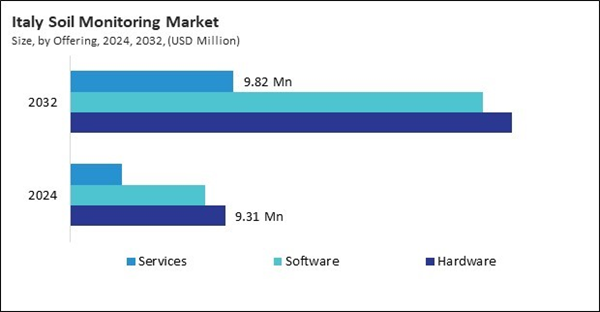The Europe Soil Monitoring Market is expected to witness market growth of 14.3% CAGR during the forecast period (2025-2032).
The Germany market dominated the Europe Soil Monitoring Market by country in 2024, and is expected to continue to be a dominant market till 2032; thereby, achieving a market value of $125.8 million by 2032. The UK market is exhibiting a CAGR of 12.8% during 2025-2032. Additionally, the France market is expected to experience a CAGR of 15% during 2025-2032.
Modern systems now incorporate wireless sensor networks, satellite imagery, and cloud-based data analytics to provide comprehensive insights into soil health. These innovations have enhanced the ability to monitor soil conditions at various depths and across extensive geographic areas, offering valuable data for precision agriculture, environmental conservation, and climate change mitigation. Government agencies and research institutions have played a pivotal role in this evolution.
For instance, the USDA's Soil Climate Analysis Network (SCAN) provides nationwide soil moisture and temperature data to support agricultural and environmental research. Similarly, the National Coordinated Soil Moisture Monitoring Network (NCSMMN) aims to integrate various soil moisture data sources to improve drought monitoring and water resource management. Original Equipment Manufacturers (OEMs) have also contributed significantly by developing advanced soil sensors and monitoring equipment.
This market in Europe has evolved over the decades from static soil surveys and manual sampling techniques into a sophisticated ecosystem of digital tools, remote sensing technologies, and smart agricultural practices. Over time, the scope of soil monitoring expanded beyond traditional agronomy to include climate resilience, biodiversity conservation, and pollution control. Technological innovation has accelerated the evolution of soil monitoring in Europe. This market in Europe is undergoing a transformative phase, shaped by advancements in technology, evolving regulatory frameworks, and growing awareness of soil health as a cornerstone of sustainable agriculture and climate resilience. The first major trend is the alignment of soil monitoring initiatives with broader European environmental goals, particularly those set out in the EU Soil Strategy for 2030 and the European Green Deal. Thus, Europe's soil monitoring landscape is being redefined by a convergence of innovation, policy, and ecological priorities, paving the way for more resilient land management and environmental stewardship.
The Germany market dominated the Europe Soil Monitoring Market by country in 2024, and is expected to continue to be a dominant market till 2032; thereby, achieving a market value of $125.8 million by 2032. The UK market is exhibiting a CAGR of 12.8% during 2025-2032. Additionally, the France market is expected to experience a CAGR of 15% during 2025-2032.
Modern systems now incorporate wireless sensor networks, satellite imagery, and cloud-based data analytics to provide comprehensive insights into soil health. These innovations have enhanced the ability to monitor soil conditions at various depths and across extensive geographic areas, offering valuable data for precision agriculture, environmental conservation, and climate change mitigation. Government agencies and research institutions have played a pivotal role in this evolution.
For instance, the USDA's Soil Climate Analysis Network (SCAN) provides nationwide soil moisture and temperature data to support agricultural and environmental research. Similarly, the National Coordinated Soil Moisture Monitoring Network (NCSMMN) aims to integrate various soil moisture data sources to improve drought monitoring and water resource management. Original Equipment Manufacturers (OEMs) have also contributed significantly by developing advanced soil sensors and monitoring equipment.
This market in Europe has evolved over the decades from static soil surveys and manual sampling techniques into a sophisticated ecosystem of digital tools, remote sensing technologies, and smart agricultural practices. Over time, the scope of soil monitoring expanded beyond traditional agronomy to include climate resilience, biodiversity conservation, and pollution control. Technological innovation has accelerated the evolution of soil monitoring in Europe. This market in Europe is undergoing a transformative phase, shaped by advancements in technology, evolving regulatory frameworks, and growing awareness of soil health as a cornerstone of sustainable agriculture and climate resilience. The first major trend is the alignment of soil monitoring initiatives with broader European environmental goals, particularly those set out in the EU Soil Strategy for 2030 and the European Green Deal. Thus, Europe's soil monitoring landscape is being redefined by a convergence of innovation, policy, and ecological priorities, paving the way for more resilient land management and environmental stewardship.
List of Key Companies Profiled
- Campbell Scientific, Inc.
- CropX, Inc.
- Element Materials Technology (Temasek Holdings)
- Irrometer Company, Inc.
- METER Group, Inc.
- Spectrum Technologies, Inc. (BAE Systems PLC)
- Acclima, Inc.
- SGS S.A.
- The Toro Company
- Stevens Water Monitoring Systems, Inc.
Market Report Segmentation
By Application
- Agricultural
- Non-agricultural
By Offering
- Hardware
- Software
- Services
By Type
- Ground-based Sensing
- Sensing & Imagery
- Robotic & Telematics
By Country
- Germany
- UK
- France
- Russia
- Spain
- Italy
- Rest of Europe
Table of Contents
Chapter 1. Market Scope & Methodology
Chapter 2. Market at a Glance
Chapter 3. Market Overview
Chapter 4. Competition Analysis - Global
Chapter 5. Value Chain Analysis of Soil Monitoring Market
Chapter 6. Europe Soil Monitoring Market by Application
Chapter 7. Europe Soil Monitoring Market by Offering
Chapter 8. Europe Soil Monitoring Market by Type
Chapter 9. Europe Soil Monitoring Market by Country
Chapter 10. Company Profiles
Companies Mentioned
- Campbell Scientific, Inc.
- CropX, Inc.
- Element Materials Technology (Temasek Holdings)
- Irrometer Company, Inc.
- Irrometer Company, Inc.
- Spectrum Technologies, Inc. (BAE Systems PLC)
- Acclima, Inc.
- SGS S.A.
- The Toro Company








